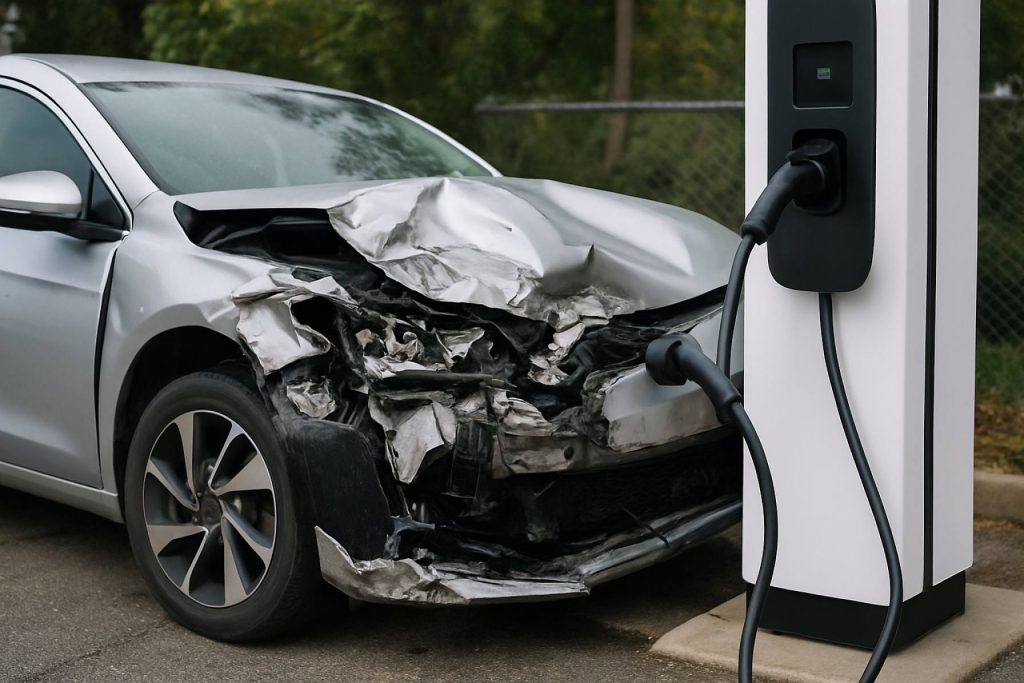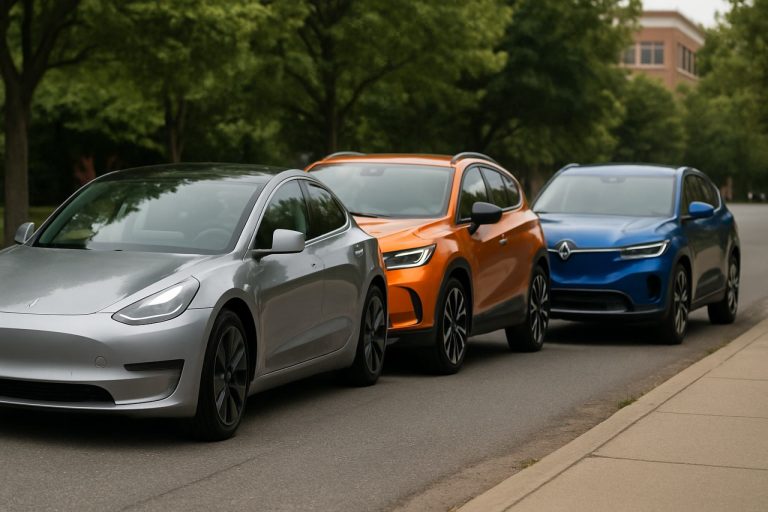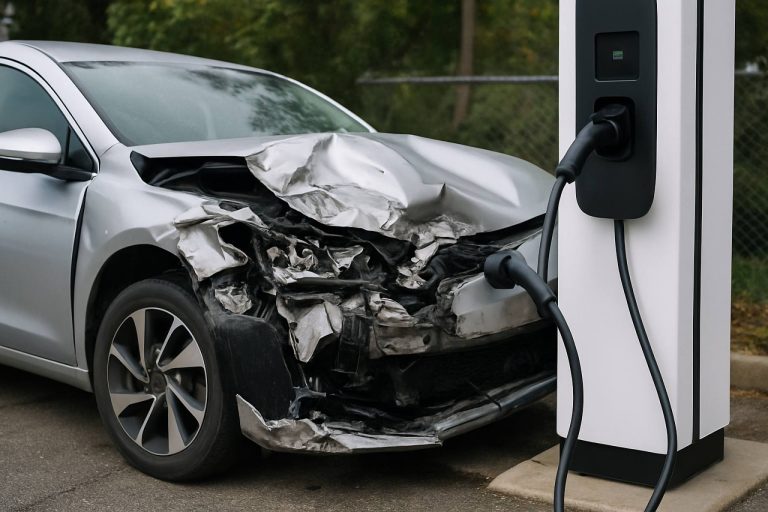
- Fellten transforms discarded electric vehicle batteries into “second-life” energy storage solutions, reducing waste and boosting sustainability.
- The Charge Qube is a mobile power station housed in robust steel containers, capable of charging multiple vehicles where grid access is limited or costly.
- Innovative design allows businesses and fleets to access affordable, scalable EV charging without complex infrastructure or planning delays.
- The concept supports clean transport expansion in diverse environments, from busy cities to remote locations worldwide.
- Beyond just recycling, Fellten’s approach champions a circular economy by harnessing the untapped potential of used EV batteries—pushing the boundaries of the EV revolution.
Beneath the sullen skies of Bristol, two battered vehicles arrive at Fellten’s headquarters, carried by a rumbling flatbed. Most would consider this the final chapter for a Tesla Model 3 and a battered Ford van—endings, not beginnings. Yet, for Chris Hazell, these ruins are brimming with untapped promise. As the clatter dies down, another chapter ignites for their battered battery packs: the pulse of a revolution in how we power the future.
At the nexus where British ingenuity and environmental urgency collide, Fellten reimagines what discarded batteries can do. Their latest creation, the Charge Qube, towers behind security fencing—ten feet of ISO-certified corrugated steel, engineered to host up to six “second-life” EV battery arrays. Picture a mobile power station, deployable to the remotest outpost or the busiest city street, humming quietly with the capacity to charge a fleet where the grid cannot reach, or where its connection is slow, challenging, or prohibitively expensive.
For years, Hazell raced the boundaries of combustion—and found their limits. Early days tinkering with race cars on the racing circuits gave way to orchestrating power for megawatt-hungry spectacles like the London Olympics and Glastonbury Festival. But with fossil fuel fumes fading from favor, Hazell pivoted, recognizing that true performance—on the road or off—required new thinking. The internal combustion engine, he saw, was a solved problem. Electric vehicles, on the other hand, sparked new opportunity.
Fellten—meaning “lightning” in Welsh—emerged as the answer to that call. From its modest Yate base, Hazell’s team of engineers cracked open the “black box” of battery conversions, pulling back the curtain for the world. Their YouTube videos, as transparent as they were technical, drew in enthusiasts and gnawed open the secretive shell long surrounding the industry.
This open approach rippled through celebrity garages and silver screen backlots. Electric stunt cars raced onto sets for blockbuster films. BMW entrusted classic Minis to Fellten’s electrifying touch. Even the ever-mischievous Mr. Bean found his way behind the wheel of a yellow G-plate Mini, retrofitted for a new age.
Yet, as the drumbeat for bespoke EV conversions quieted, demand for a different vision grew: scalable, affordable, and transformative energy storage. Enter Charge Qube—a mobile juggernaut able to store up to 450kWh of repurposed power and simultaneously charge ten cars. With rapid-charging versions in the pipeline—delivering up to 240kW—the concept pivots from rarefied custom builds to a real-world solution for depots, fleets, and forgotten corners of the electric map.
Notably, these containers require no arduous planning applications or tricky infrastructure. Businesses can plug their commercial fleets in overnight, harvesting power when energy is cheap or the wind strong—making the prospect of electrifying busy van and truck fleets not just greener, but genuinely practical. Hazell envisions thousands of these units scattered from Europe to Africa and Australia, pushing clean transport further and faster.
And for the doubters who suggest recycling is the endgame, Hazell taps the brakes. He foresees a world where battery chemistry shifts, perhaps even beyond lithium, challenging the economics of conventional recycling. Second life, reclaiming utility from the bones of yesterday’s marvels, may prove not only more sustainable, but more valuable over time.
Above all, the eclectic journey of Fellten underscores a growing truth: in this new era, ingenuity means thinking in cycles, not straight lines. From battered wrecks to mobile grid-savers, Hazell’s vision embodies a circular, creative response to climate challenge.
This is the heartbeat of the modern EV revolution—one forged in curiosity, passed through the discipline of engineering, and realized in the vivid hum of second chances.
For more on innovation shaping the automotive world, visit BBC or explore leading automotive updates at Autocar.
Key takeaway: As the world edges towards electrification, the next leap may come not from brand new batteries, but from creative reimagining of what we already have—proving that, with vision and nerve, even discarded parts can charge a global transformation.
This $1 Battery Idea Could Disrupt the EV Revolution—Here’s How “Frankenstein Batteries” Could Charge Up the World
Exploring Fellten’s Charge Qube: The Future of Second-Life EV Batteries
Fellten’s Charge Qube is not just another power station—it encapsulates a paradigm shift in electric vehicle (EV) battery reuse, scalability, and sustainable power storage. While the source article highlights the compelling journey of founder Chris Hazell and Fellten’s innovative strategies, there’s even more below the surface that makes the Charge Qube and Fellten’s vision worth dissecting. Here’s a deeper dive—including specs, industry context, use cases, and what it means for the global push toward electrification.
—
What Makes Charge Qube Unique: Tech Specs & Features
– Second-Life Battery Arrays: Charge Qube leverages retired EV battery packs—often deemed unfit for cars but still retaining up to 80% usable capacity—turning “waste” into a scalable storage asset.
– Storage Capacity: Each unit can store up to 450kWh; that’s enough to charge ten standard EVs, power a small off-grid village for days, or keep a commercial depot operational overnight (source: IEA).
– Portability & Deployment: Unlike stationary grid storage, Charge Qube’s ISO shipping container format means it can be delivered and deployed anywhere a truck can reach—no permits or civil engineering required.
– Rapid Charging Pipeline: Next-gen models will enable up to 240kW DC fast charging, surpassing many public charging stations.
– Plug-and-Play System: No need for deep grid connections or complex installation; it’s truly modular and mobile.
—
Real-World Use Cases & Industry Impact
How-To: Rapid Fleet Electrification
1. Identify existing fleet depot locations or off-grid outposts with limited power access.
2. Deploy Charge Qube units via flatbed; no major groundwork needed.
3. Plug in the fleet for overnight charging, leveraging off-peak or renewable energy.
4. Rotate or relocate units as needs shift.
Pro tip: Use energy arbitrage—charge the Qube from wind/solar when power is cheap, then top up vehicles at night to cut costs and emissions.
Game-Changers for Events and Emergencies
– Festivals & Sports Events: Replace diesel generators entirely for clean, silent power.
– Disaster Response: Offer emergency islanded microgrids after storms or outages.
– Emerging Markets: Bring reliable power where grid is weak or absent, accelerating electrification in rural Africa, Asia, or Australia.
—
Market Forecasts & Industry Trends
– Global Second-Life Battery Market: Expected to reach $4.2 billion by 2025 (Source: BloombergNEF).
– Battery Supply Challenge: New EV batteries remain expensive and resource-intensive. Second-life solutions like Charge Qube delay recycling, adding a valuable intermediate use.
– Sustainability Push: Regulations are tightening in the EU, US, and China for battery reuse/recycling—a tailwind for solutions like this.
For more on the global EV market, check out BBC and Autocar.
—
Security, Compatibility & Sustainability
– ISO-Certified: Units are built to international shipping container standards—secure, stackable, easy to transport.
– Smart BMS (Battery Management System): Monitors pack health, balances cells, and mitigates thermal runaway risks.
– Lifecycle Extension: Adds up to 10 more years of productive life to batteries before recycling, maximizing resource efficiency.
– Circular Economy: Reduces demand for new raw lithium/cobalt and lowers e-waste.
—
Pros, Cons & Limitations
Pros:
– Fast deployment anywhere
– Lower carbon footprint vs. new batteries
– Cuts infrastructure costs
– Flexible: supports grid, off-grid, or hybrid use
Cons:
– Dependent on steady supply of used batteries
– Performance may vary based on battery provenance
– Still requires responsible end-of-life recycling
Emerging Controversies:
Some environmentalists worry about “postponing the problem” of recycling, while others highlight that battery chemistries are evolving—meaning today’s solutions could require adaptation in the next decade. Lithium-iron-phosphate (LFP) and solid-state batteries, for example, have different reuse and recycling profiles than older chemistries.
—
Reviews & Industry Reception
– Fellten’s transparent approach (via YouTube and open engineering) has been praised by tech enthusiasts and industry experts for breaking down the “black box” of battery reuse.
– Automotive brands like BMW and media properties have entrusted iconic cars and high-profile film sets to their expertise.
– Third-party field reports attest to the reliability and utility of mobile battery banks for both public and private sector clients.
—
Answers to Top Reader Questions
Q: How long can a Charge Qube last?
A: With quality second-life batteries and proper BMS, typical lifespan is 7-10 years before final recycling.
Q: How safe are second-life batteries?
A: With rigorous pack testing and continuous monitoring, safety is comparable to first-life installations.
Q: What are the economic benefits?
A: Companies can save up to 60% compared to new grid-tied solutions; payback is usually <5 years depending on energy prices (Source: Allied Market Research).
—
Quick Actionable Recommendations
– For Fleet Managers: Consider modular storage like Charge Qube for immediate depot electrification—bypassing grid delays.
– For Event Planners: Replace diesel generators with mobile battery storage for cleaner, quieter operations.
– For Green Entrepreneurs: Explore partnerships in emerging markets for community microgrids using second-life batteries.
– For Tech Tinkerers: Follow Fellten’s open engineering for DIY retrofits and conversions—start with safer, smaller projects first.
—
Final Thoughts
The future of electrification is not just new EVs and fresh batteries—it’s a smarter, circular approach where yesterday’s cast-offs power tomorrow’s progress. Fellten’s Charge Qube shows that with ingenuity and openness, even battered tech can spark the next chapter in our clean energy transition.
For more on cutting-edge transportation and energy revolutions, check trusted sources like BBC and Autocar.
Key keywords: Second-life batteries, mobile energy storage, EV charging, Charge Qube, sustainable power, battery recycling, circular economy, fleet electrification, Fellten, portable EV charger.



